
Looking for How to Make Homemade Canned Pickled Corn Relish - Easily! With Step-by-step Photos, Recipe, Directions, Ingredients and Costs in 2025? Scroll down this page and follow the links. And if you bring home some fruit or vegetables and want to can, freeze, make jam, salsa or pickles, see this page for simple, reliable, illustrated canning, freezing or preserving directions. There are plenty of other related resources, click on the resources dropdown above. If you are having a hard time finding canning lids, I've used these, and they're a great price & ship in 2 days.
If you have questions or feedback, please let me know! There are affiliate links on this page. Read our disclosure policy to learn more.
How to Make Homemade Canned Pickled Corn Relish - Easily! With Step-by-step Photos, Recipe, Directions, Ingredients and Costs
How to Make Homemade Canned Pickled Corn Relish
Making and canning your own pickled corn relish is easy! You can do it with basic equipment already in your kitchen - you just need a canning pot. And thanks to the vinegar in pickled corn relish, you can use either a plain open water bath pot or a Pressure Canner ( without the weight on) (which will also let you can low acid vegetables!)
So, here's how to can pickled corn relish! The directions are complete with instructions in easy steps and completely illustrated. In the winter when you open a jar, the pickled corn relish will taste MUCH better than any store-bought canned pickled corn relish!
Prepared this way, the jars have a shelf life of about 12 months, and aside from storing in a cool, dark place, require no special attention.
Directions for Making Canned Pickled Corn Relish
Click here for a PDF print version
Yield: About 9 pints
Ingredients
- 10 cups fresh whole kernel corn (from 16 to 20 medium-size ears, or six 10-ounce packages of frozen corn)
- 2-1/2 cups diced sweet red peppers
- 2-1/2 cups diced sweet green peppers
- 2-1/2 cups chopped celery
- 1-1/4 cups diced onions
- 1-3/4 cups sugar or Stevia (in a prepared form like Truvia, it measures same as sugar; if you use another form, you will need do your own conversion) - or Splenda, if you prefer,
- 5 cups vinegar (5% acidity), white or apple cider
- 2-1/2 tbsp canning or pickling salt
- 2-1/2 tsp celery seed
- 2-1/2 tbsp dry mustard
- 1-1/4 tsp turmeric
Equipment
- Jar grabber (to pick up the hot jars)
- Jar funnel ($4 at mall kitchen stores and local "big box" stores, but it's usually cheaper online from our affiliates)
- At least 1 large pot
- Large spoons and ladles,
- Canning jars (often called Ball jars, Mason jars or Kerr jars) (Publix, Kroger, other grocery stores and some "big box" stores carry them - about $7 per dozen pint jars including the lids and rings)
- 1 Water Bath Canner OR a Pressure Canner (a large pressure pot with a lifting rack to sanitize the jars after filling about $75 to $200 at mall kitchen stores and "big box" stores, but it is cheaper online; see this page for more about pressure canners).
Recipe and Directions
Step 1 - Get yer corn!
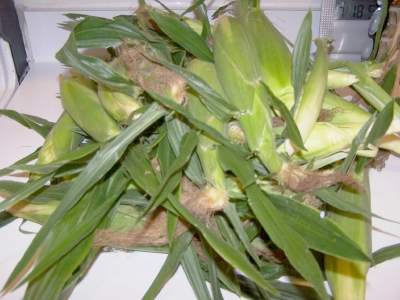 Start
with fresh corn on the cob - as fresh as you can get. If there is a
delay between harvesting and canning, put it in the refrigerator or put
ice on it. The sugars break down quickly at room temperature.
According to the USDA, about 32 pounds (in husk) of sweet corn is needed
per canner load of 7 quarts; an average of 20 pounds is needed per canner
load of 9 pints. Note that a bushel weighs 35 pounds and yields 6 to 11
quarts of canned corn, which is an average of 41/2 pounds of corn in the
husks per quart of finished canned corn.
Start
with fresh corn on the cob - as fresh as you can get. If there is a
delay between harvesting and canning, put it in the refrigerator or put
ice on it. The sugars break down quickly at room temperature.
According to the USDA, about 32 pounds (in husk) of sweet corn is needed
per canner load of 7 quarts; an average of 20 pounds is needed per canner
load of 9 pints. Note that a bushel weighs 35 pounds and yields 6 to 11
quarts of canned corn, which is an average of 41/2 pounds of corn in the
husks per quart of finished canned corn.
Step 2 - Prepare the jars, pots and canner
 Wash
the jars and lids
Wash
the jars and lids
This is a good time to get the jars ready! The dishwasher is fine for
the jars; especially if it has a "sanitize" cycle. Otherwise put the jars
in boiling water for 10 minutes. I just put the lids in a small pot of
almost boiling water for 5 minutes, and use the magnetic "lid lifter wand"
(available from target, other big box stores, and often grocery stores;
and available online - see this page) to pull them out.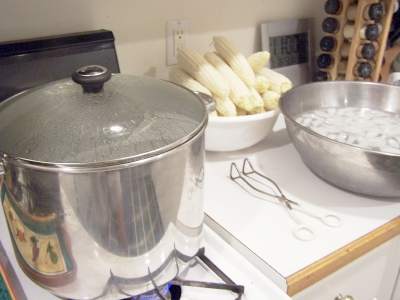
Get the large pot of boiling water ready (about 2/3 filled) and a LARGE bowl 2/3 filled with ice and cold water. --->
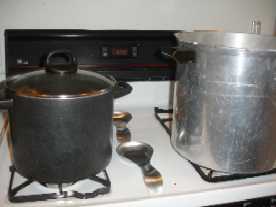
Get the canner heating up
Rinse out your canner, put the rack in the bottom, and fill it with hot tap water. (Of course, follow the instruction that came with the canner, if they are different). Put it on the stove over low heat just to get it heating up for later on.
Step 3 - Husk the corn
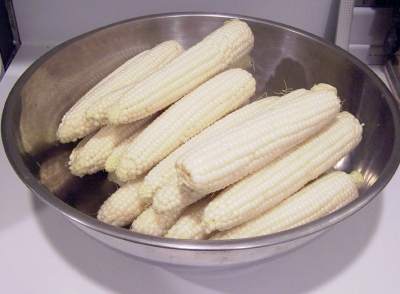 Husk
the corn and pick off as much of the silk as you can. A soft
vegetable brush is the fastest and easiest way to get the remaining silk
off - just don't be too rough with it.
Husk
the corn and pick off as much of the silk as you can. A soft
vegetable brush is the fastest and easiest way to get the remaining silk
off - just don't be too rough with it.
Step 4 - Cut the kernels from the cob
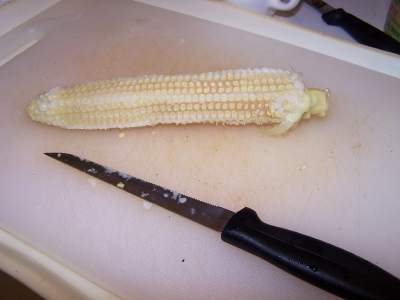 Obviously,
if you are canning the corn on the cob, skip this step.
Obviously,
if you are canning the corn on the cob, skip this step.
Whole Kernel Corn - Cut kernels from cob about 2/3 to 3/4 the depth of the kernels. I hold the ear by the small end, and slide the knife down the ear. See the next photo.
Cream Style Corn - Cut kernel tips about 1/2 deep and scrape the cobs with the back of a knife to remove the juice and the heart of the kernel.
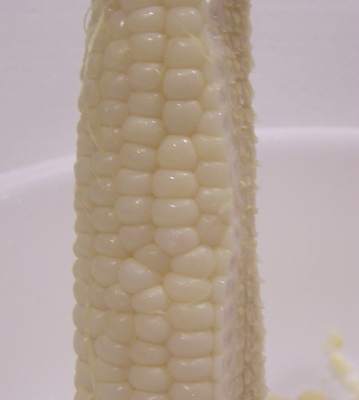 Another
way to prepare cream style corn for canning is to cut and scrape the corn
from the cob without blanching. Place the cut corn in a double boiler, and
heat with constant stirring for about 10 minutes or until it thickens; allow
to cool by placing the pan in ice water.
Another
way to prepare cream style corn for canning is to cut and scrape the corn
from the cob without blanching. Place the cut corn in a double boiler, and
heat with constant stirring for about 10 minutes or until it thickens; allow
to cool by placing the pan in ice water.
You don't need a special tool, just a very sharp knife!
However, a number of people wrote in to point out that they prefer one of the tools below, as do I, often because it is easier for them due to arthritis, or simply faster.
See here for related tools, equipment, supplies on Amazon See here for related tools, equipment, supplies on Amazon See here for related tools, equipment, supplies on Amazon
As the corn piles up in your bowl, it will look like this!
 Close
up, the corn comes off in strips. As you put these in the bag,
they will easily separate into separate kernels.
Close
up, the corn comes off in strips. As you put these in the bag,
they will easily separate into separate kernels.
Now is a good time to dice the peppers, celery and onions!
Step 5 - Heat the veggies for 5 minutes
Combine the
- 2-1/2 cups diced sweet red peppers
- 2-1/2 cups diced sweet green peppers
- 2-1/2 cups chopped celery
- 1-1/4 cups diced onions
- 1-3/4 cups sugar or Stevia (in a prepared form like Truvia, it measures same as sugar; if you use another form, you will need do your own conversion) - or Splenda, if you prefer,
- 5 cups vinegar (5% acidity), white or apple cider
- 2-1/2 tbsp canning or pickling salt
- 2-1/2 tsp celery seed
in a saucepan. Bring the mixture to boil and simmer for 5 minutes, stirring occasionally.
Step 6 - Add the mustard, turmeric and simmer for 5 minutes
Mix the
- 2-1/2 tbsp dry mustard
- 1-1/4 tsp turmeric
in with 1/2 cup of the simmered mixture. Add this mixture and the corn to the hot mixture in the pot. Simmer for another 5 minutes. If desired, thicken mixture with flour paste (1/4 cup flour blended in 1/4 cup water) and stir frequently.
Step 7 - Packing the corn relish in the canning jars
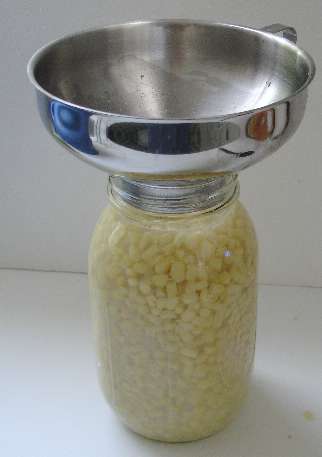 This
is called "hot packing"! Fill the jars with the corn mixture, leaving
1/2-inch headspace. Pack the jars fairly tightly, but be sure to leave
1/2-inch of space at the TOP of the jar. That is called "headspace"
and is needed for expansion during heating in the water bath.
This
is called "hot packing"! Fill the jars with the corn mixture, leaving
1/2-inch headspace. Pack the jars fairly tightly, but be sure to leave
1/2-inch of space at the TOP of the jar. That is called "headspace"
and is needed for expansion during heating in the water bath.
The photo only shows corn, but it should be everything (the photo was blurry, so I'm using a photo from canning corn)
Step 8 - Pour boiling cooking liquid into each packed jar
Use a ladle or Pyrex measuring cup to carefully fill each packed jar with the hot vinegar solution, again allowing 1/2-inch headspace. The relish should be covered and there should still be 1/2 inch of airspace left in the top of each jar. Be careful not to burn yourself, (or anyone else - children should be kept back during this step!)
Step 9 - Put the lids and rings on
Put the lids on each jar and seal them by putting a ring on and screwing it down snugly (but not with all your might, just "snug").
Step 10 - Put the jars in the canner and the lid on the canner
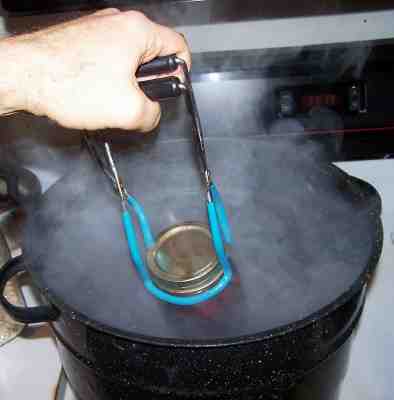 Using
the jar tongs, put the jars on the rack in the canner. Make sure
the tops of the jars are covered by at least 1 inch of water.
Using
the jar tongs, put the jars on the rack in the canner. Make sure
the tops of the jars are covered by at least 1 inch of water.
Step 11 - Process for 15 minutes*
The chart below will help you determine the right processing time and pressure, if you have a different type of canner, or are above sea level. For most people, using a plain open water bath canner, the time will be 15 to 20 minutes. You can use either a plain water bath canner OR if you only have a Pressure Canner; just don't put the weights on it, which uses it as a water bath canner.
| Recommended process time for Pickled Corn Relish in a boiling-water canner. | |||
|
Hot pack |
Process Time at Altitudes of |
||
|
Jar Size |
0 - 1,000 ft |
1,001 - 6,000 ft |
Above 6,000 ft |
|
Half-pints or Pints |
15 minutes |
20 minutes |
25 minutes |
Step 12 - Remove the jars
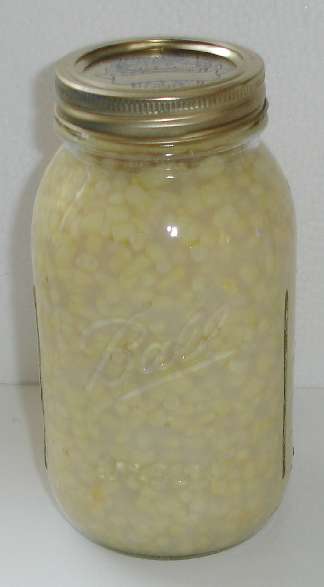 Lift
the jars out of the water and let them cool on a wooden cutting board or
a towel, without touching or bumping them in a draft-free place
(usually takes overnight), here they won't be bumped. You can then
remove the rings if you like, but if you leave them on, at least loosen
them quite a bit, so they don't rust in place due to trapped moisture.
Once the jars are cool, you can check that they are sealed verifying
that the lid has been sucked down. Just press in the center, gently,
with your finger. If it pops up and down (often making a popping sound),
it is not sealed. If you put the jar in the refrigerator right away, you
can still use it. Some people replace the lid and reprocess the jar,
then that's a bit iffy. If you heat the contents back up, re-jar them
(with a new lid) and the full time in the canner, it's usually ok.
You're done!
Lift
the jars out of the water and let them cool on a wooden cutting board or
a towel, without touching or bumping them in a draft-free place
(usually takes overnight), here they won't be bumped. You can then
remove the rings if you like, but if you leave them on, at least loosen
them quite a bit, so they don't rust in place due to trapped moisture.
Once the jars are cool, you can check that they are sealed verifying
that the lid has been sucked down. Just press in the center, gently,
with your finger. If it pops up and down (often making a popping sound),
it is not sealed. If you put the jar in the refrigerator right away, you
can still use it. Some people replace the lid and reprocess the jar,
then that's a bit iffy. If you heat the contents back up, re-jar them
(with a new lid) and the full time in the canner, it's usually ok.
You're done!
This document was adapted from the "Complete Guide to Home Canning," Agriculture Information Bulletin No. 539, USDA, revised 1994.
Other Equipment:
- Jar lifting tongs to pick up hot jars
- Lid lifter - to remove lids from the pot of boiling water (sterilizing )
- Lids- disposable - you may only use them once
- Ring - holds the lids on the jar until after the jars cool - then you remove them, save them and reuse them
- Canning Jar funnel - to fill the jars
Frequently Asked Questions
Q. Is it safe to can pickled corn relish in a traditional water bath? If so how long do you do process them?
A. Yes! Pickled vegetables have added vinegar which adds acid and lowers the pH, making it safe to can in a water bath canner (or a Pressure Canner) See the table in step
Plain canned corn (not pickled) require a pressure canner. Quoting from the Ohio State University Extension's Fact Sheet:
"Pressure canning is the only safe method for home canning vegetables. Clostridium botulinum is the bacterium that causes botulism food poisoning in low-acid foods, such as vegetables. The bacterial spores are destroyed only when the vegetables are processed in a Pressure Canner at 240 degrees Fahrenheit (F) for the correct amount of time.Clostridium botulinum is the bacterium commonly found in vegetables and meats. It is harmless until it finds itself in a moist, low-acid, oxygen-free environment or a partial vacuum. Under these conditions, the bacterium can grow and produce toxins dangerous to people and animals.
Do not process (low acid) vegetables using the boiling water bath because the botulinum bacteria can survive that method.
Can fruits and vegetables be canned without heating if aspirin is used? No. Aspirin should not be used in canning. It cannot be relied on to prevent spoilage or to give satisfactory products. Adequate heat treatment is the only safe procedure.
Salt and sugar are not preservatives for vegetables: they are added to stabilize and improve flavor, but will not prevent spoilage.
Salicylic acid is also NOT a preservative. The University of Illinois reports:
Using Aspirin for Canning
Several years ago, a recipe circulated using aspirin to acidify tomatoes and corn
for canning. Aspirin is not recommended for canning. While it contains salicylic acid, it does not sufficiently acidify tomatoes or corn
for safe hot water bath canning. Corn is low acid food and may only be processed safely in a Pressure Canner unless it is pickled. Lemon juice or vinegar is recommended to acidify tomato products for safe water bath processing; but use an approved, tested recipe.
Think of it like smoking. We all know someone who smoke their entire life and lived to be 90. But the cemeteries are filled with the vast majority who didn't. You will hear people say "my grandmother did it that way for 20 years". But of course, the people who died from food poisoning aren't around and often didn't have descendants to tell their tale...
Looking for canning equipment and supplies?
Water bath canner with a jar rack
Pressure canners for gas, electric and induction stoves: Presto 23Qt or T-fal 22Qt
Canning scoop (this one is PERFECT)
Ball Blue book (most recent version)
Jars: 8oz canning jars for jams
Find Other types of farms:
Farm markets and roadside stands
Road trips and camping resources
Local Honey, apiaries, beekeepers
Consumer fraud and scams information
Home canning supplies at the best prices on the internet!
Maple Syrup Farms, sugarworks, maple syrup festivals
Environmental information and resources
Farms For Your Event for birthday parties, weddings, receptions, business meetings, retreats, etc.
Festivals - local fruit and vegetable festivals
Get the
most recent version of
the Ball Blue Book
With this Presto 23 quart pressure canner and pressure cooker, you can "can" everything, fruits, vegetables, jams, jellies, salsa, applesauce, pickles, even meats, soups, stews. Model 01781

You can make jams, jellies, can fruit, applesauce, salsa and pickles with water bath canners, like this Granite Ware 12-Piece Canner Kit, Jar Rack, Blancher, Colander and 5 piece Canning Tool Set



